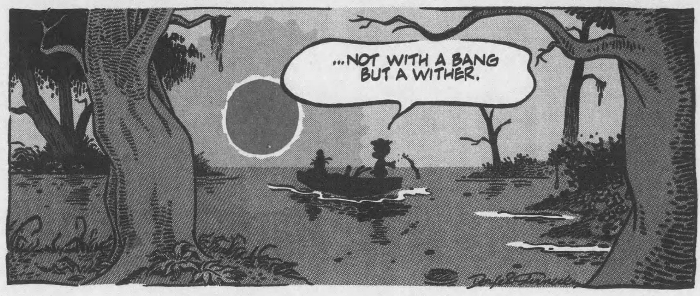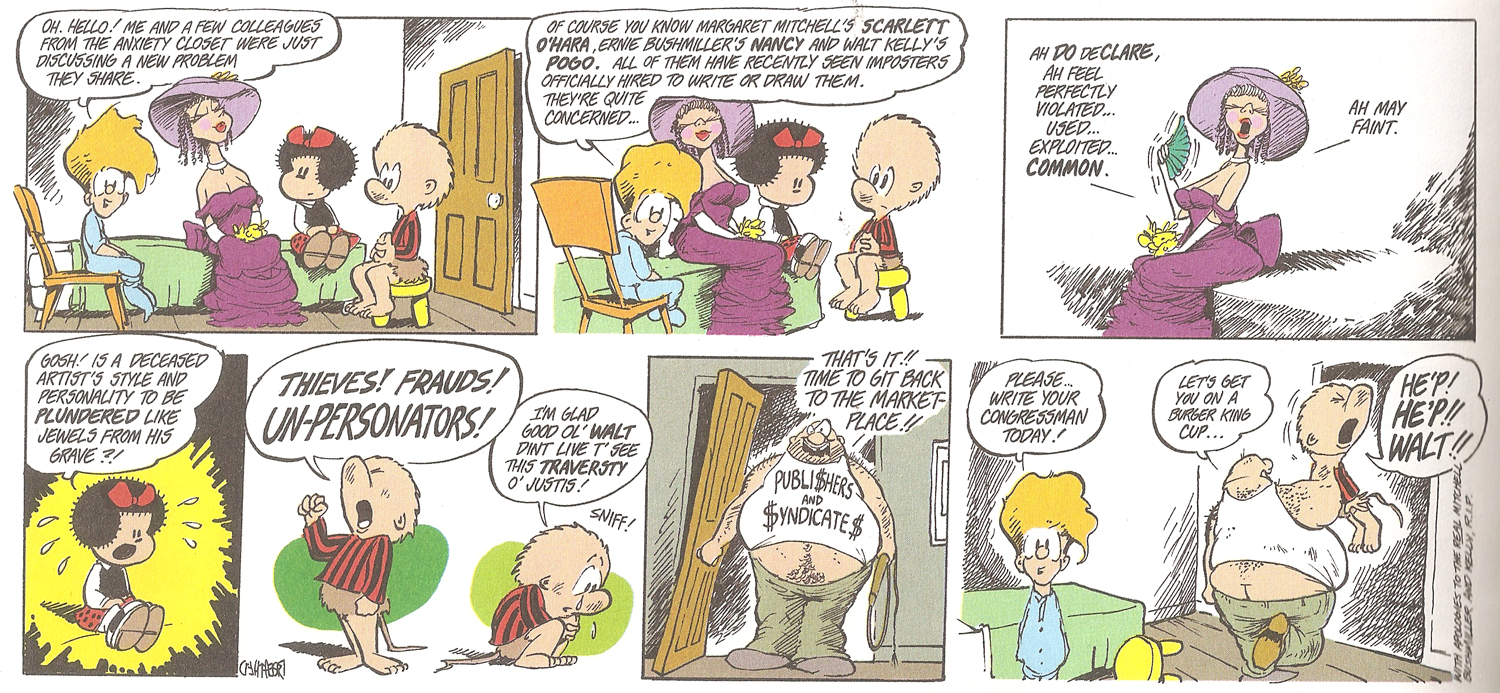
In the late 80s, something shocking happened: Pogo returned to the newspaper comics page. It was not only one of the most legendary strips of all time but one of the most influential. You may have noticed most of the top cartoonists we grew up with have cited creator Walt Kelly as the #1 influence on their own careers. Calvin and Hobbes creator Bill Watterson honed his drawing style on trying to match Kelly's.
So if it was coming back, why weren't they all happy about it? Because it was without the involvement of Kelly...the man had been dead since 1973. Even though comic strips go on beyond the lives of their creators all the time, Pogo was seen as too sacred a cow. There was immediate outrage. Garry Trudeau and Berke Breathed both spoke out directly against the resurrection -- it might've been the only time the rivalrous pair agreed on anything.

But it wasn't publi$hers and $yndicate$ who wanted Pogo back, it was Kelly's family, who noticed the media awareness of his creation had diminished significantly by the 1980s. The $yndicate$ were resistant to the idea, believing Pogo was too "wordy" for a modern audience -- basically too smart. They saw no value in it at all. Only the LA Times Syndicate was willing to take a chance on it, after the Kellys hired two men from Chicago -- Larry Doyle as script writer and Neal Sternecky as artist -- to bring the swamp back to life.
Despite the negative noise, my local paper, The Oregonian, not only picked up Walt Kelly's Pogo in January 1989 but rolled out the red carpet and gave it the royal treatment. Both the daily and Sunday versions were given space and the Sunday version instantly landed the most primo spot on the page, right on the front -- directly below the "Sunday Funnies" banner as the first thing you saw (a position previously only reserved for Peanuts and Garfield).
I was oblivious to all this. All I knew as a first-grader funnies fan was that there was this new strip with a bunch of weird animals in it. The books were long gone -- you wouldn't find any at Waldenbooks or B. Dalton. This controversial reboot was the ONLY REASON I knew what Pogo was.
And I LOVED IT.
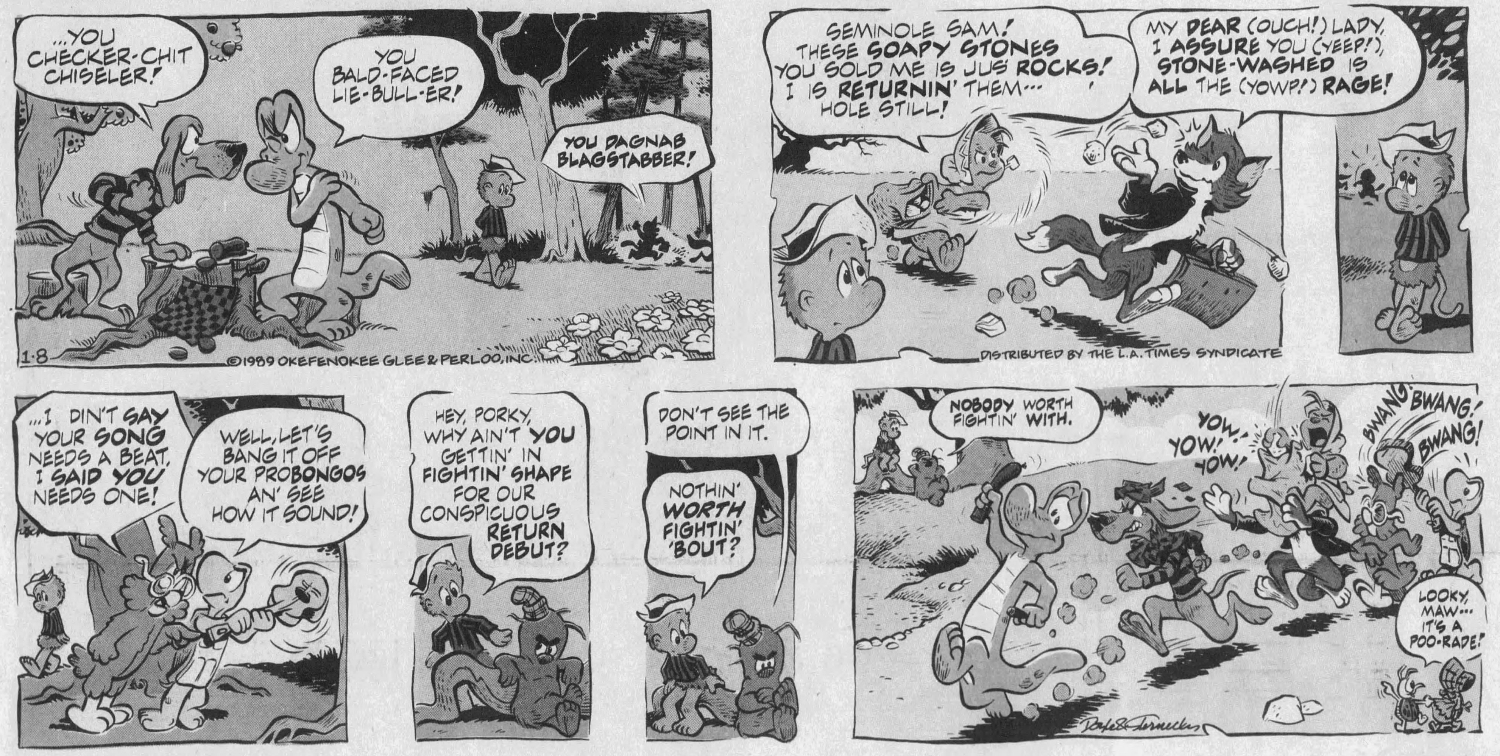
How could a kid not love this, really? The lush forested backgrounds, the rubbery well-inked characters, the weird Seussian dialogue, it was all pretty captivating. I didn't know it was technically a copy of something older, but if I had known, I'm not sure I would have cared. Sternecky wasn't Kelly, but he came pretty darn close. And you better believe I started cutting out the panels and pasting them into notebooks! (Note: I could not find that notebook by deadline time.)
That spring, The Oregonian held a reader poll to determine which of its comic strips were the most and least popular. The general response surrounding Walt Kelly's Pogo was "BOOOO! BOOOOOOO!! THROW THOSE BUMS OUT!" They recieved several letters directly attacking the strip. The poll winner was Calvin and Hobbes, followed by Bloom County and The Far Side....while Walt Kelly's Pogo sat on the bottom with a grand total of 3 votes.
Due to commitments, it took a few weeks for The Oregonian to respond, but Walt Kelly's Pogo was formally yanked in mid-July, never to return...and right in the middle of an interesting storyline too. I was crushed. But I wasn't in charge of the world.
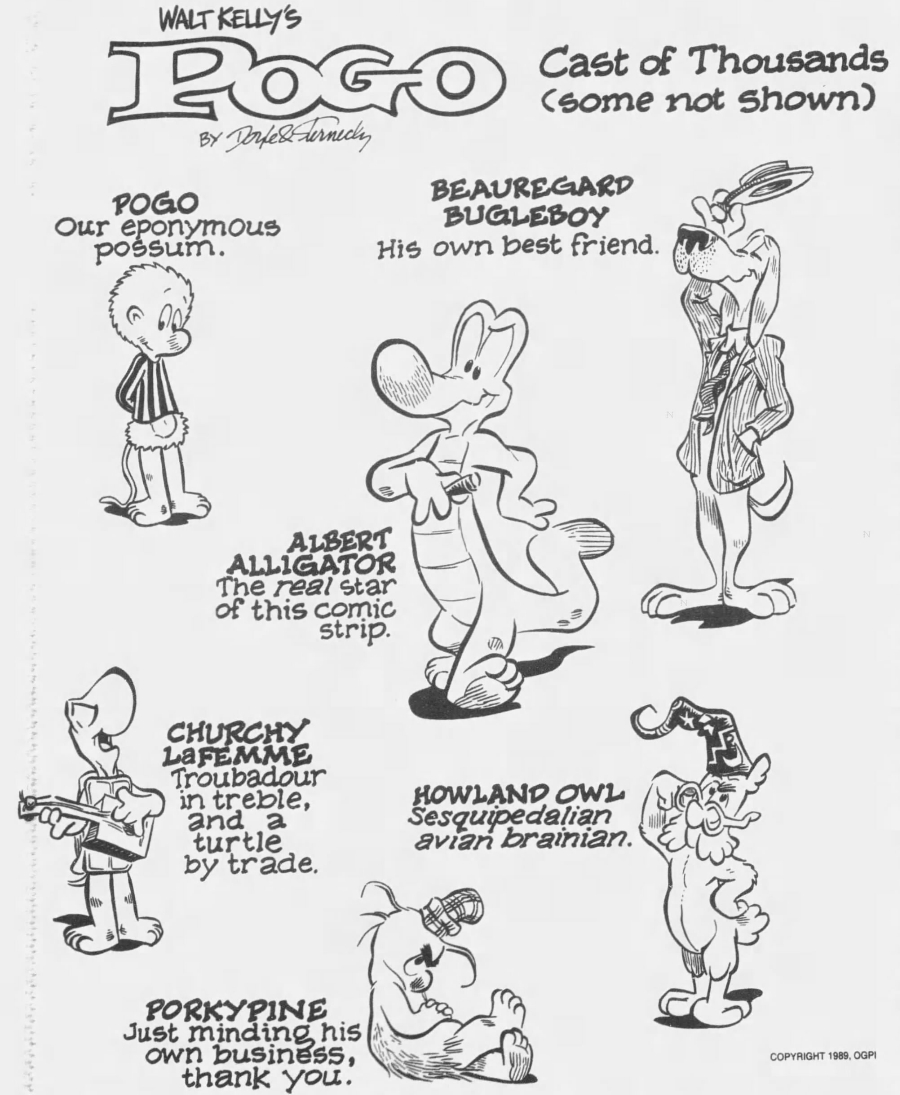
The reboot only lasted four years, sputtering out by 1993. It was never collected in any book to my knowledge, and I never got to read it beyond the point I was cut off, until scans of the entire run hit the torrent-sphere. Unfortunately they are mostly in black and white. When my dad finally got rid of his large basement stacks of newspapers, I lifted most of the funnies that had the color Pogo strips, but they're in storage now and I can't access them easily. If I ever get to it, I'll update this page with some nice color scans.
Like the original, Walt Kelly's Pogo ran different storylines in the daily and Sunday versions of itself. I'll be focusing on the Sundays since I wasn't a dailies reader at the time. Pogo has a large cast of characters, but the main ones you need to know are know-it-all Howland Owl, arrogant Albert the Alligator, Beauregard the hound dog, paranoid turtle Churchy la Femme, and the title possum himself, who serves as the straight man who reacts to everyone else. When Pogo's not serving that purpose, he delivers dry observations about society while drifting in a dinghy that goes by a different name on every panel.
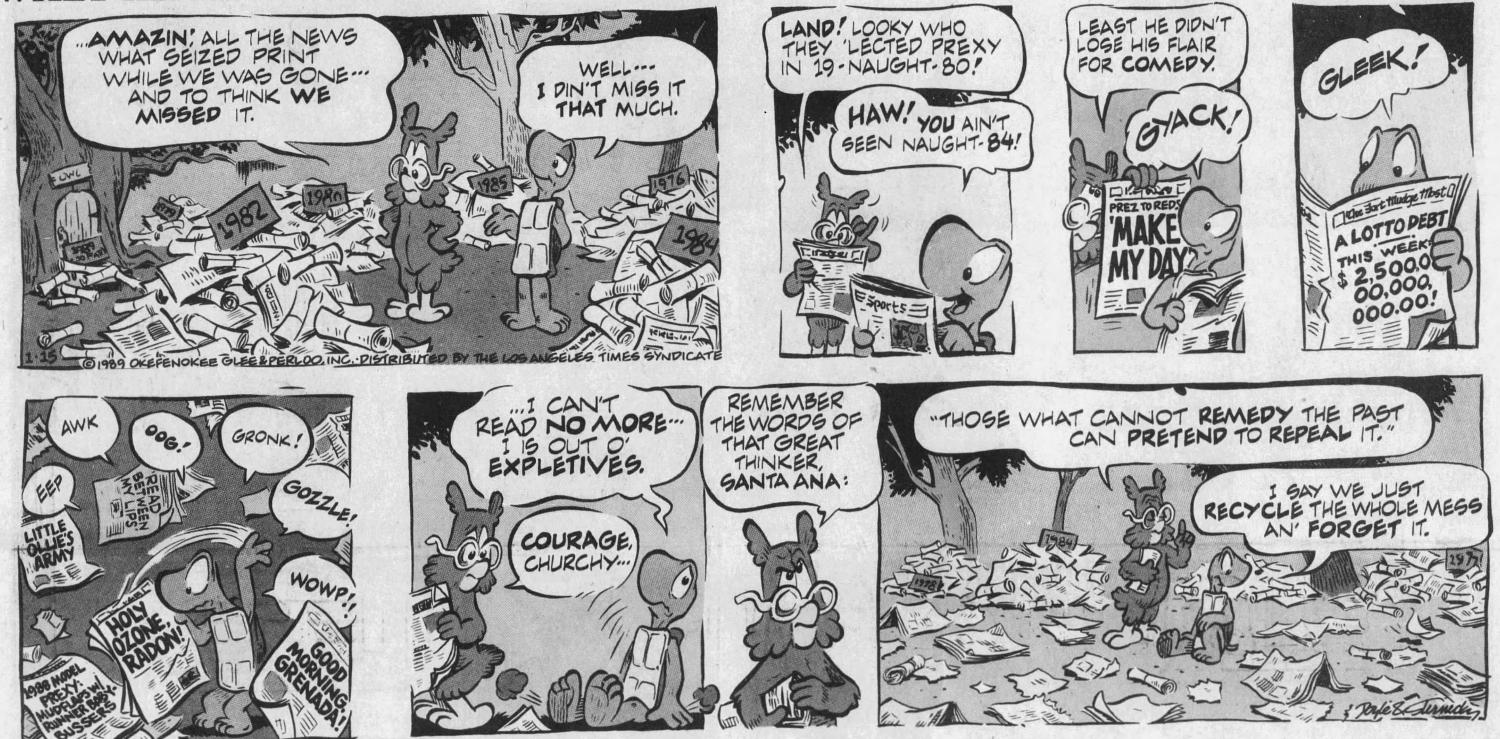
The original Pogo was, technically, a political strip -- everything that happened in the Okeefenokee Swamp paralelled something that was happening in real life. The new Pogo tries to carry on in that tradition, though the early 90s were far less eventful than the 50s and 60s, or even the 80s. Kelly had to tangle with the likes of Joseph McCarthy, but THIS strip only got two weeks to say anything about Reagan before it had to move on to the comparatively tamer George Bush Sr, who generated material about lips and broccoli and...that was about all you could do with him.
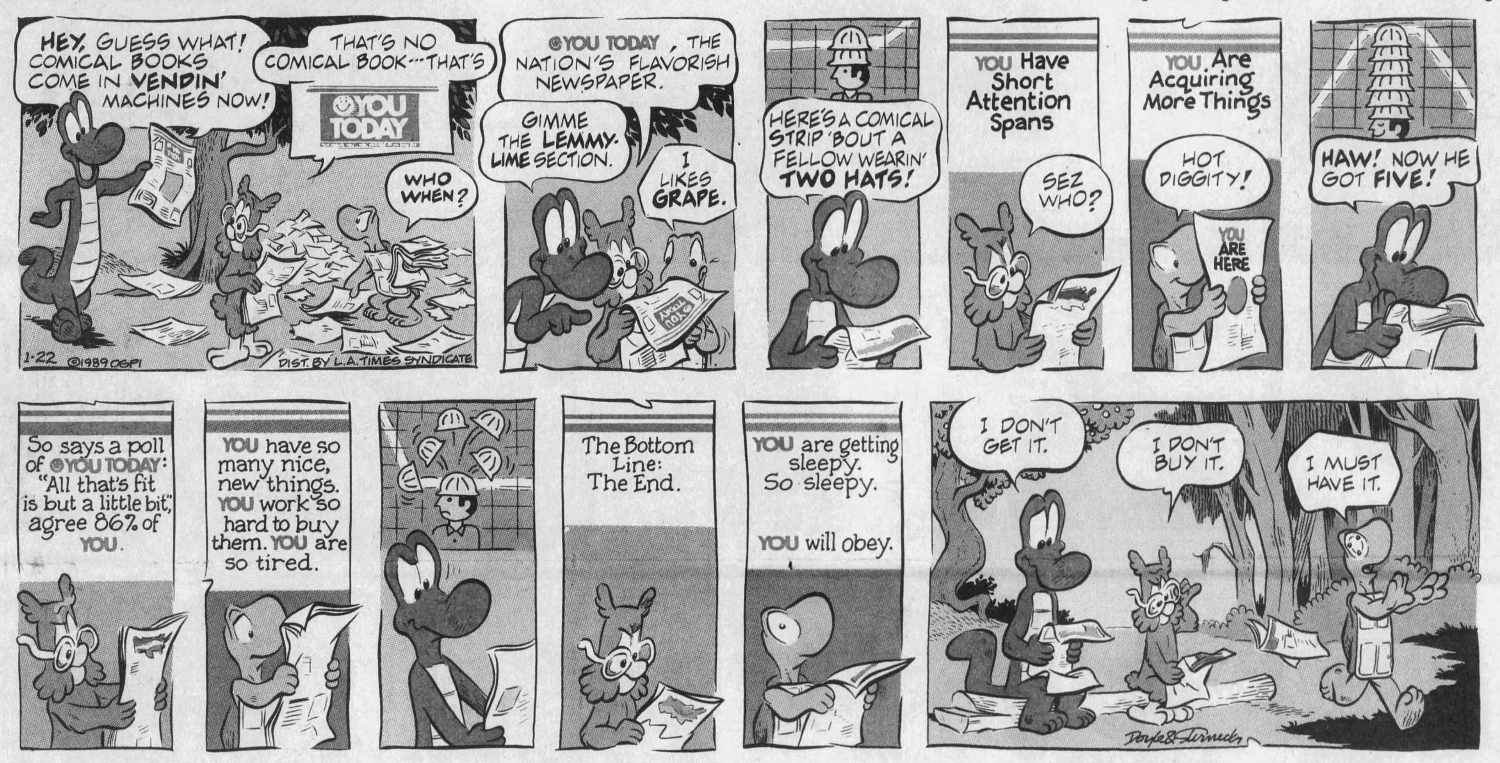
USA TODAY was a national newspaper introduced in the 1980s with the bold slogan "AMERICA'S FAVORITE NEWSPAPER" (which it claimed to be on Day One). There were fears that its influence would "dumb down" the journalism industry due to its over-reliance on feel-good stories, strange-looking graph illustrations and meaningless statistics. If the naysayers saw the state of the industry NOW they'd crap their pants, of course. Imagine the biggest threat being USA freaking TODAY. 1989 feels like paradise.
Like the cartoon suggests, each section of USA TODAY was color-coded. I never had any interest in it, because it had no comics.
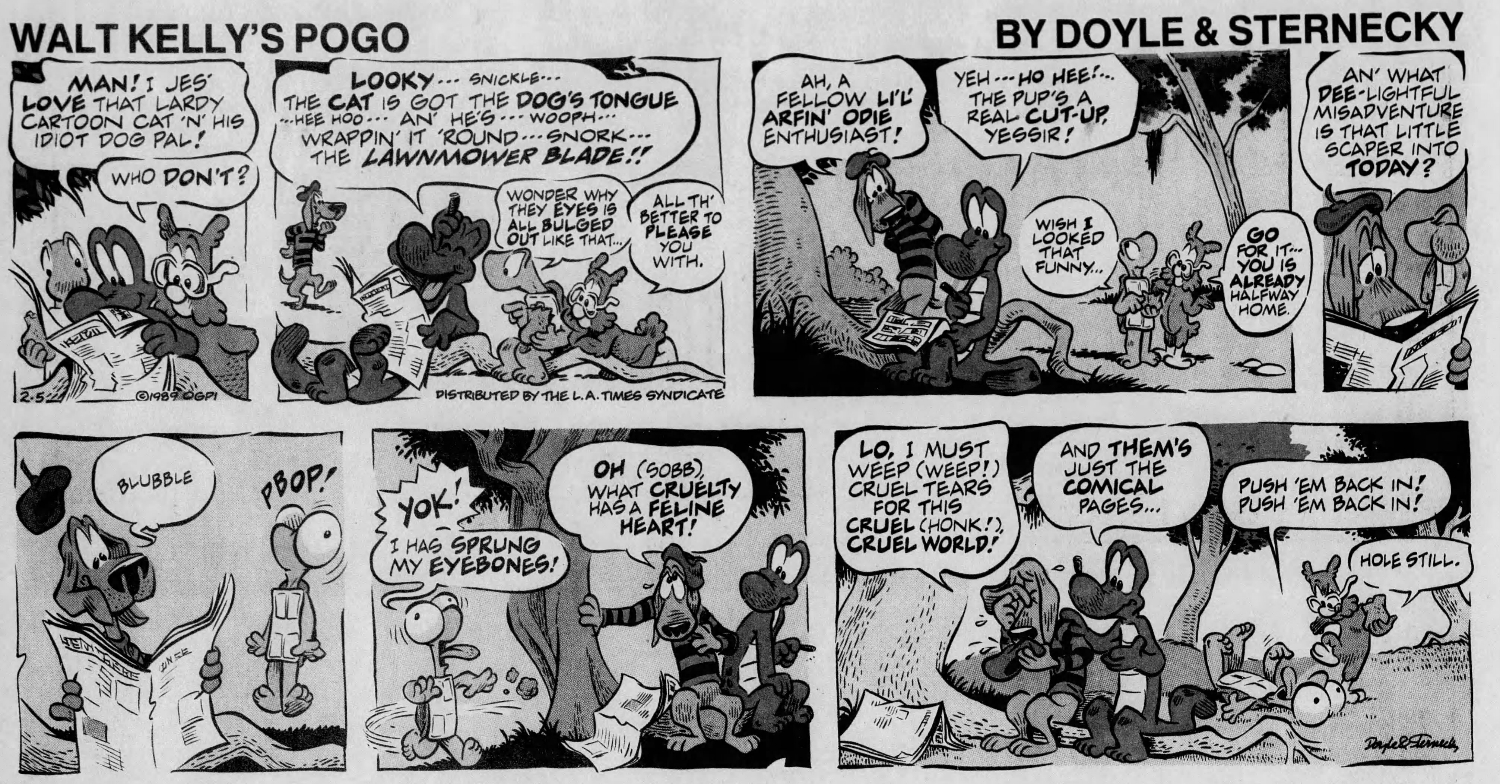
Maybe all the controversy was worth it just to get to that drawing of Churchy with his eyes bulging out.
As we've already gone over, this strip had its fair share of critics before it even started. But Pogo was not afraid to strike BACK! The first Sunday arc was about other comic strips, specifically their two biggest critics mashed into one parody called "BLOOMSBURY."
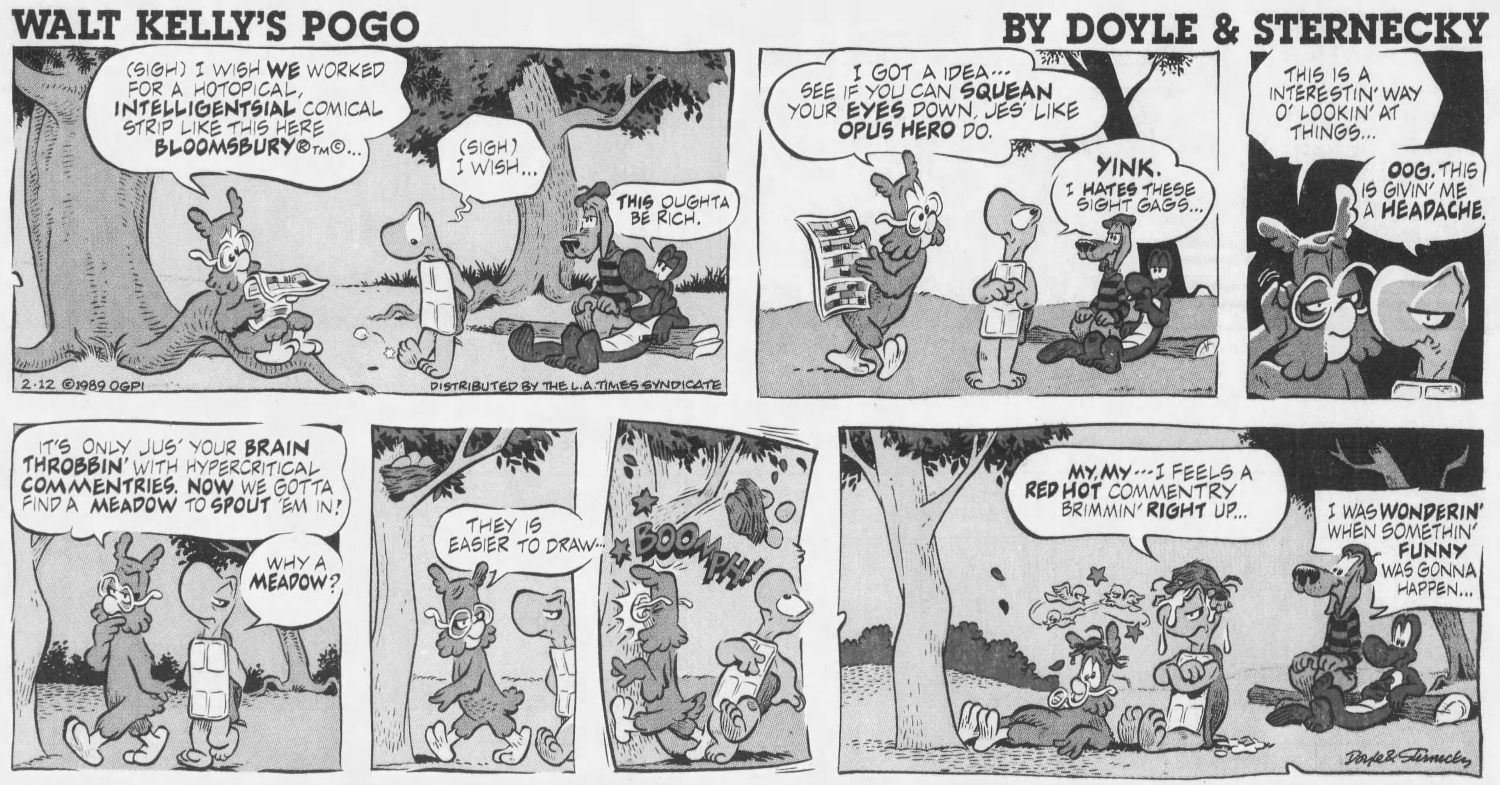
To this day I can't see a Doonesbury strip without thinking of the phrase "squeany-eyed people."
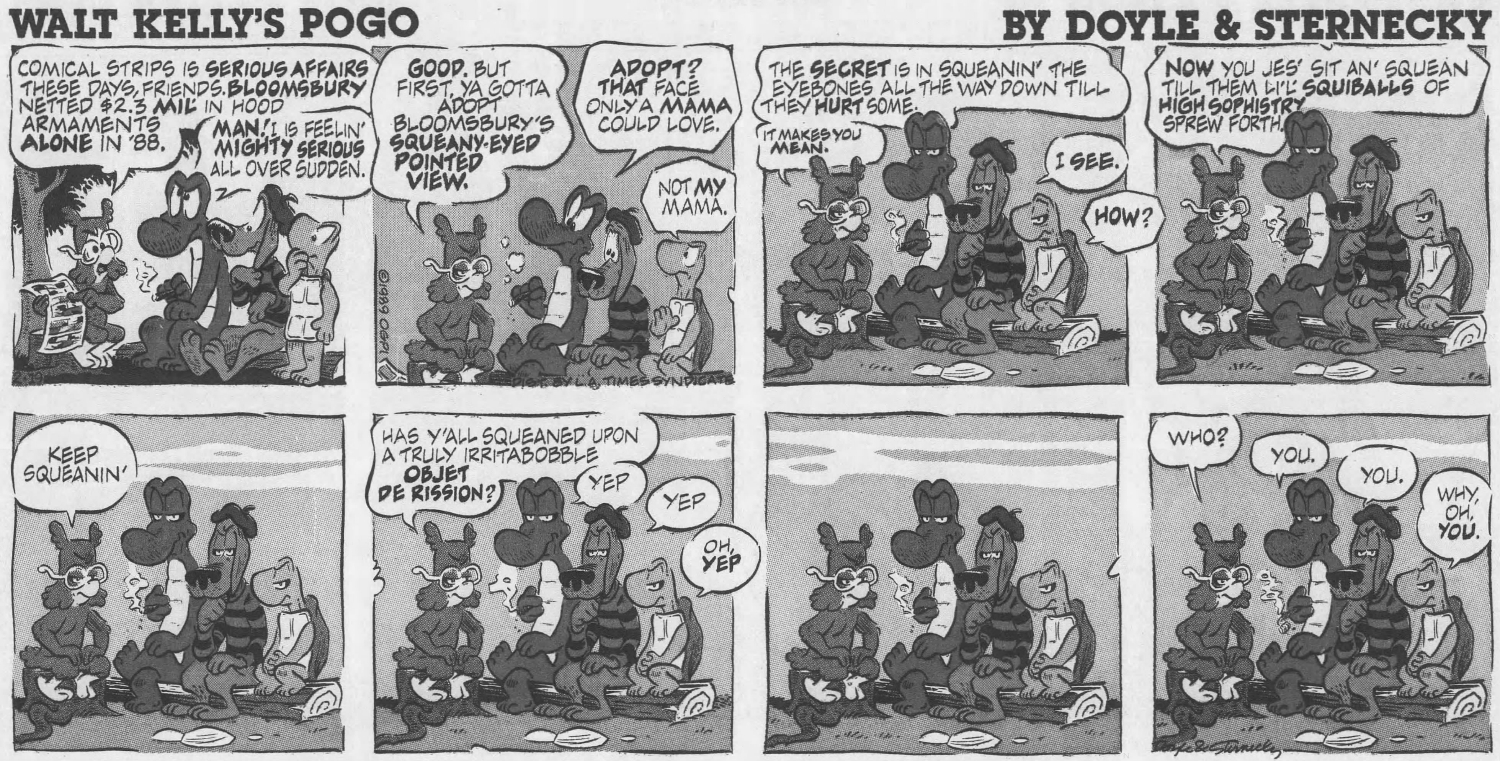
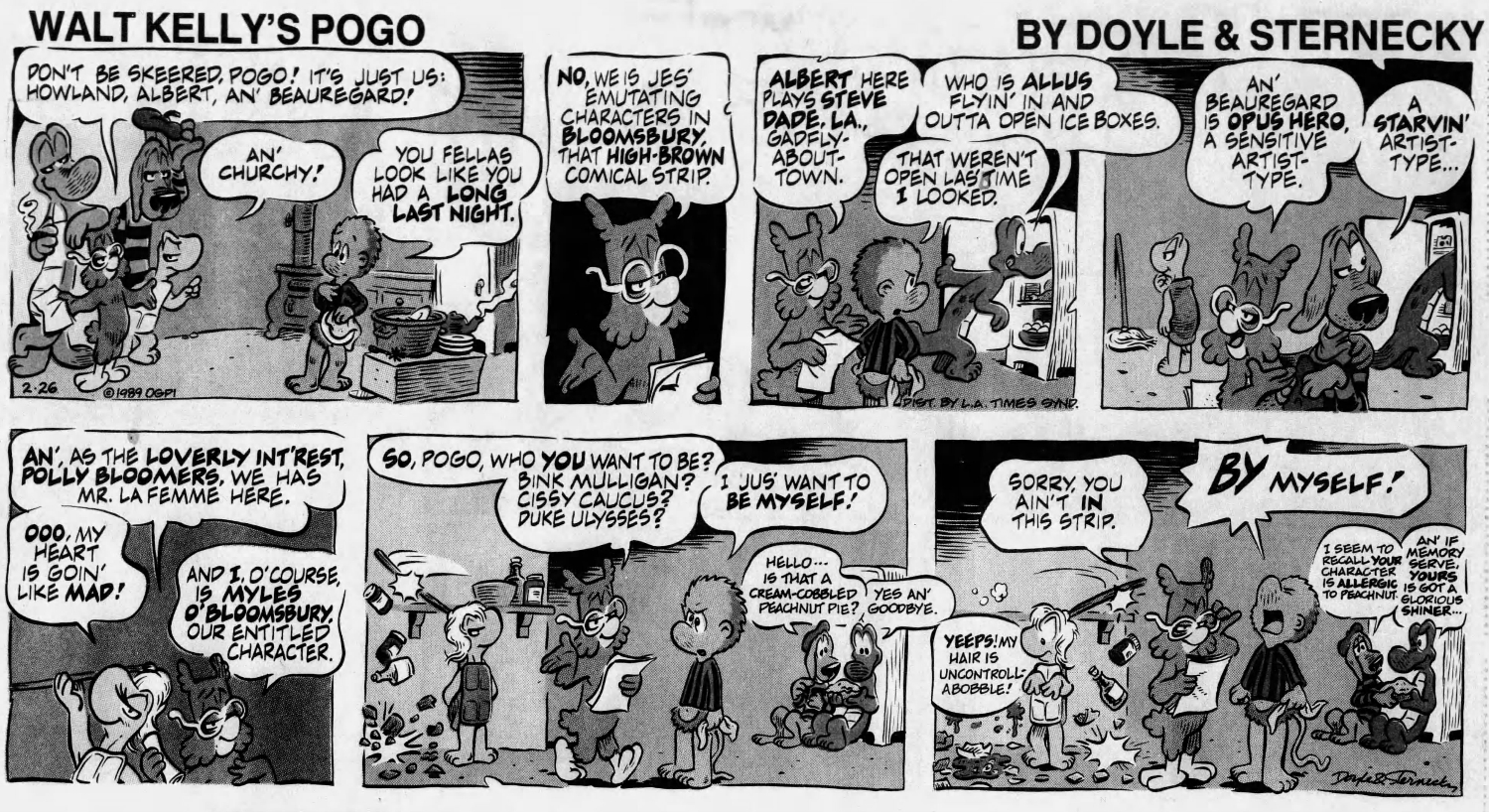
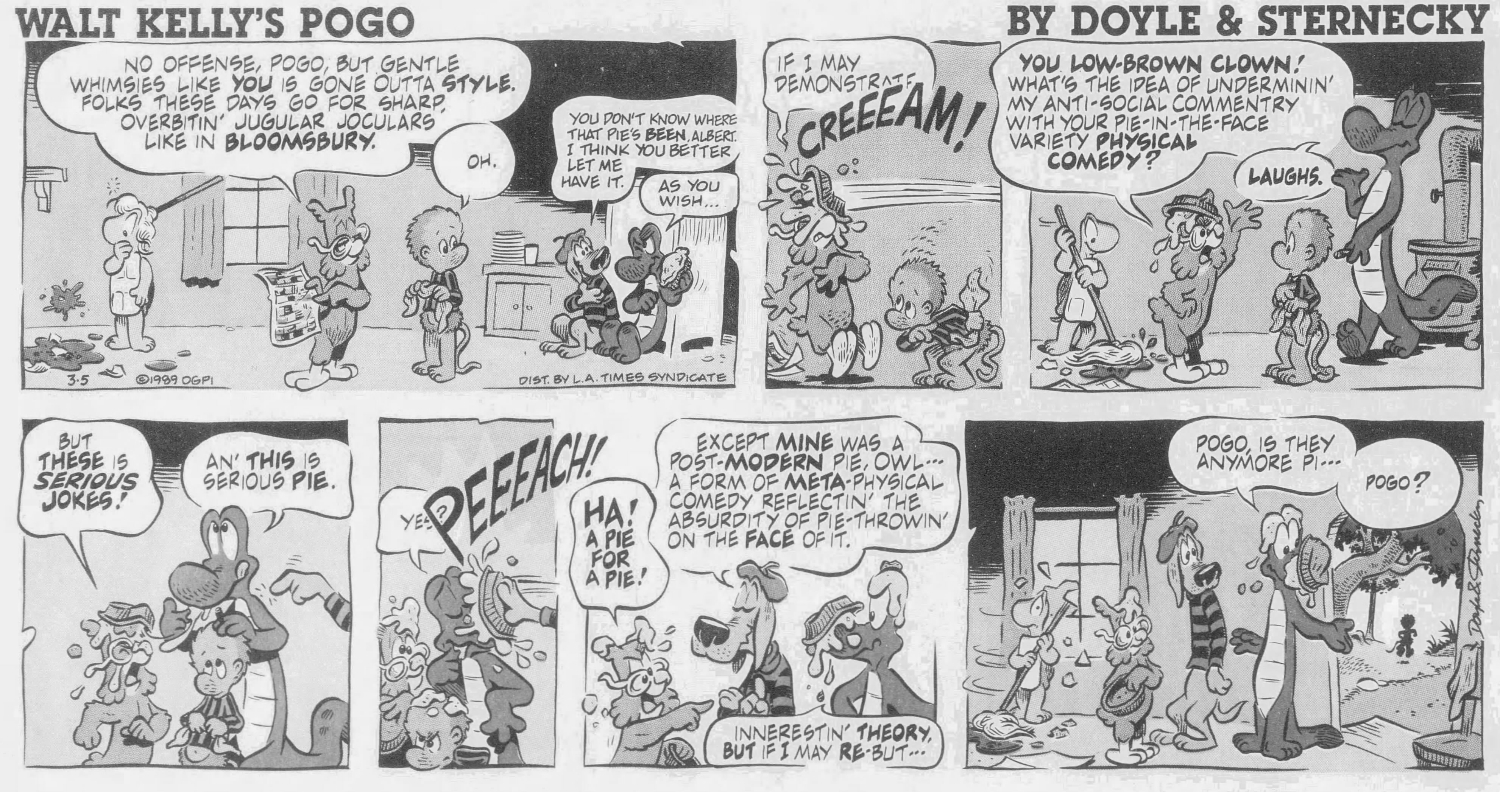
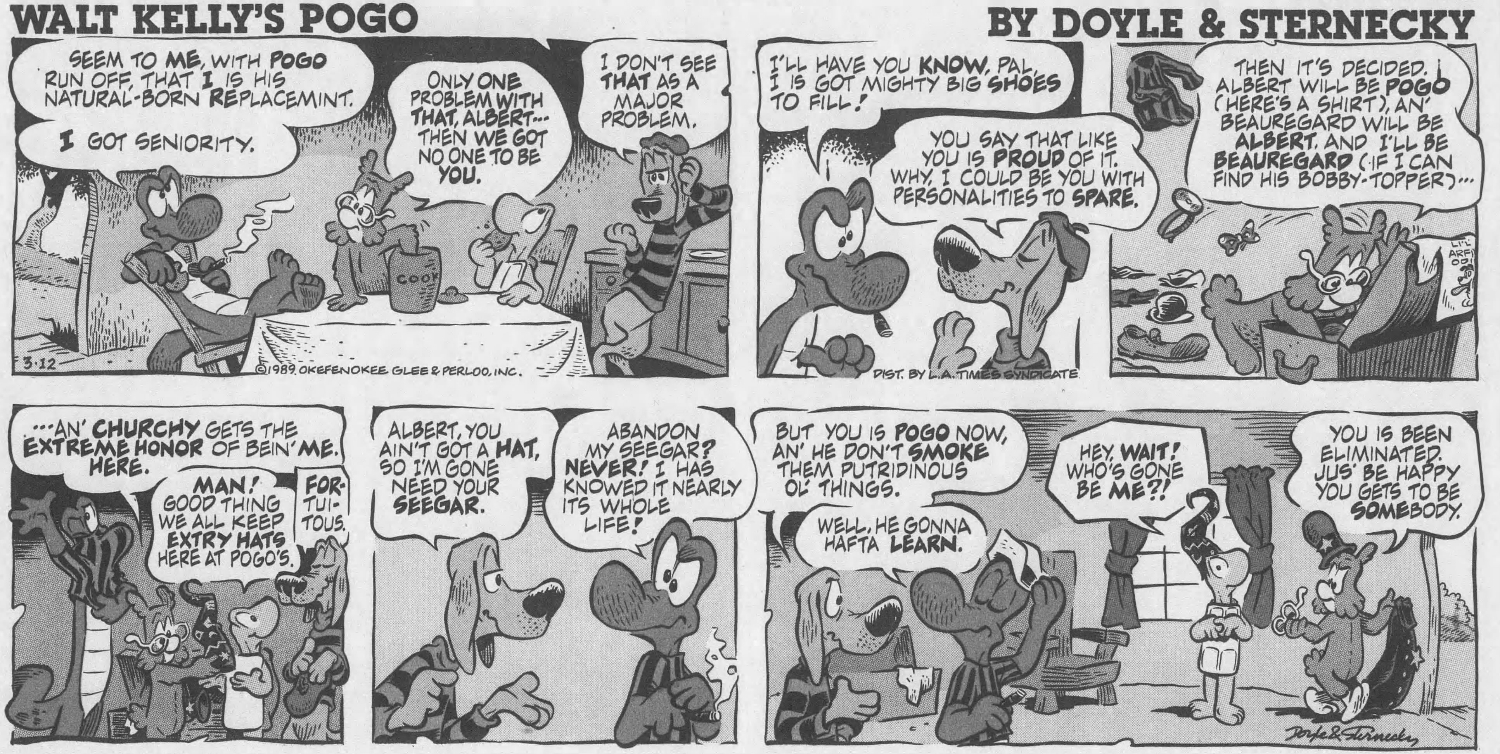
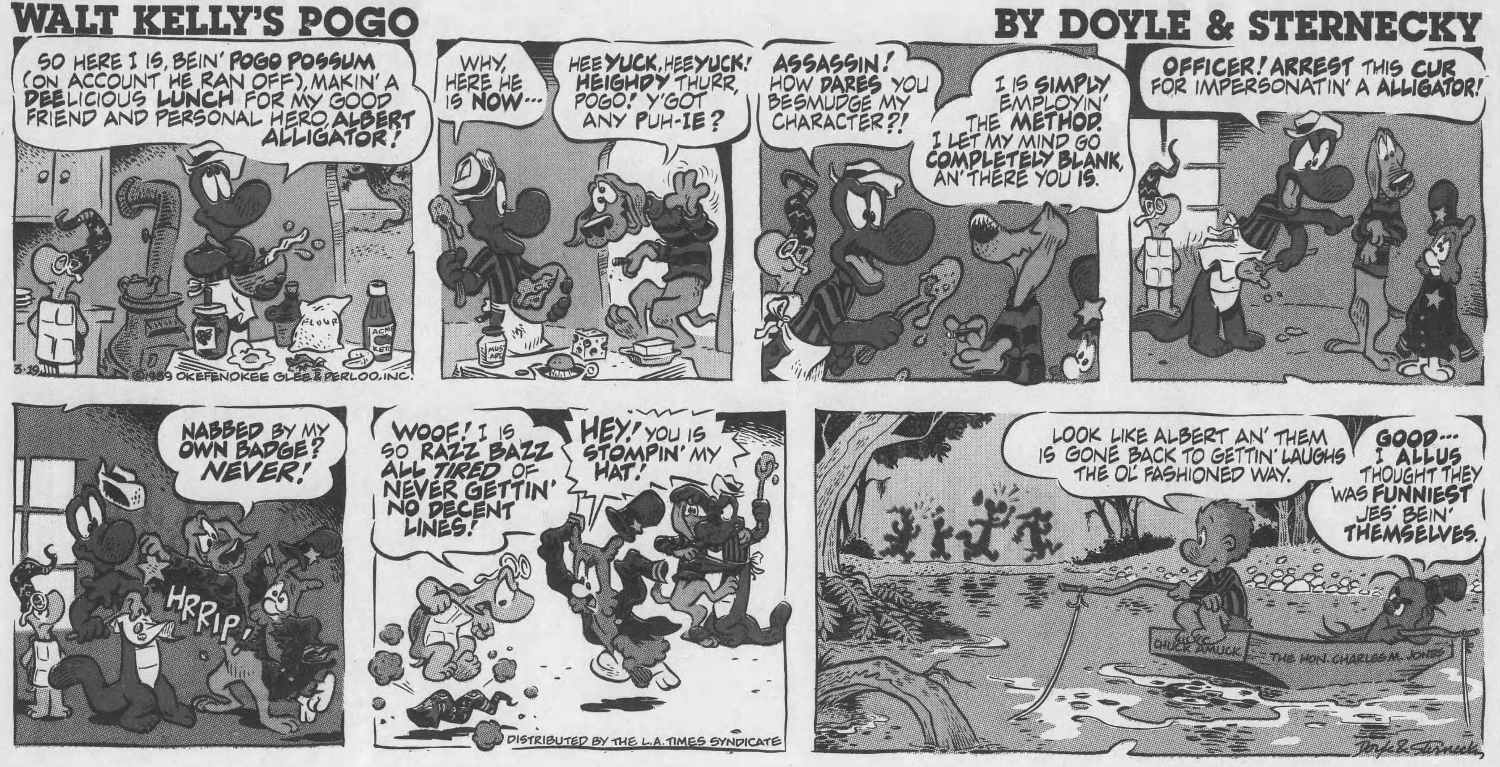
It's too bad you can't see this next one in color. The Easter Sunday strip was hand-painted by Sternecky and looks gorgeous, with pastels popping everywhere. I remember getting up on Easter morning, checking what the "bunny" had left in my basket and then seeing this strip. It encapsulated the feeling perfectly.
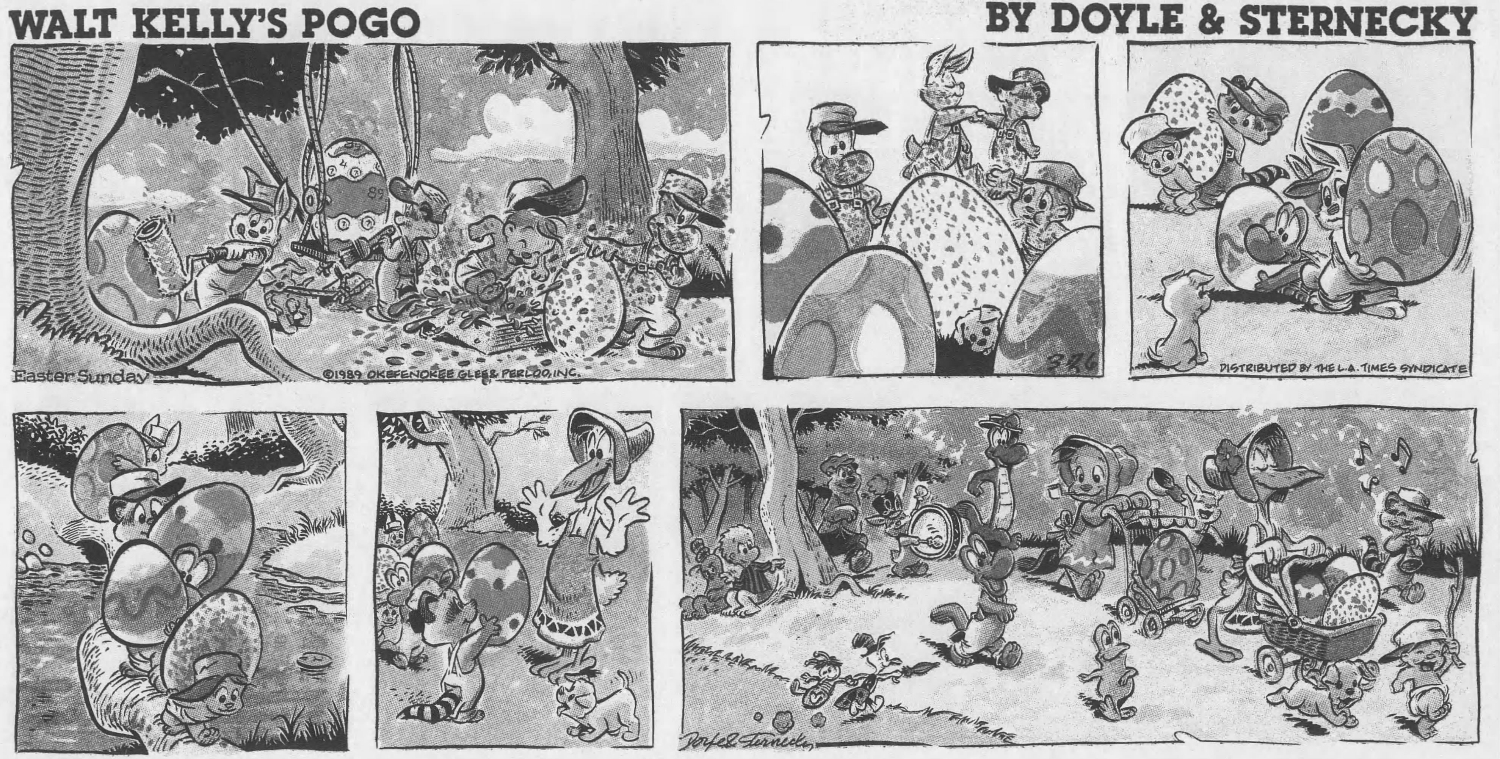
These next few are from the arc that followed, which had an environmental theme and then dovetailed into a satire on the Exxon Valdez disaster.
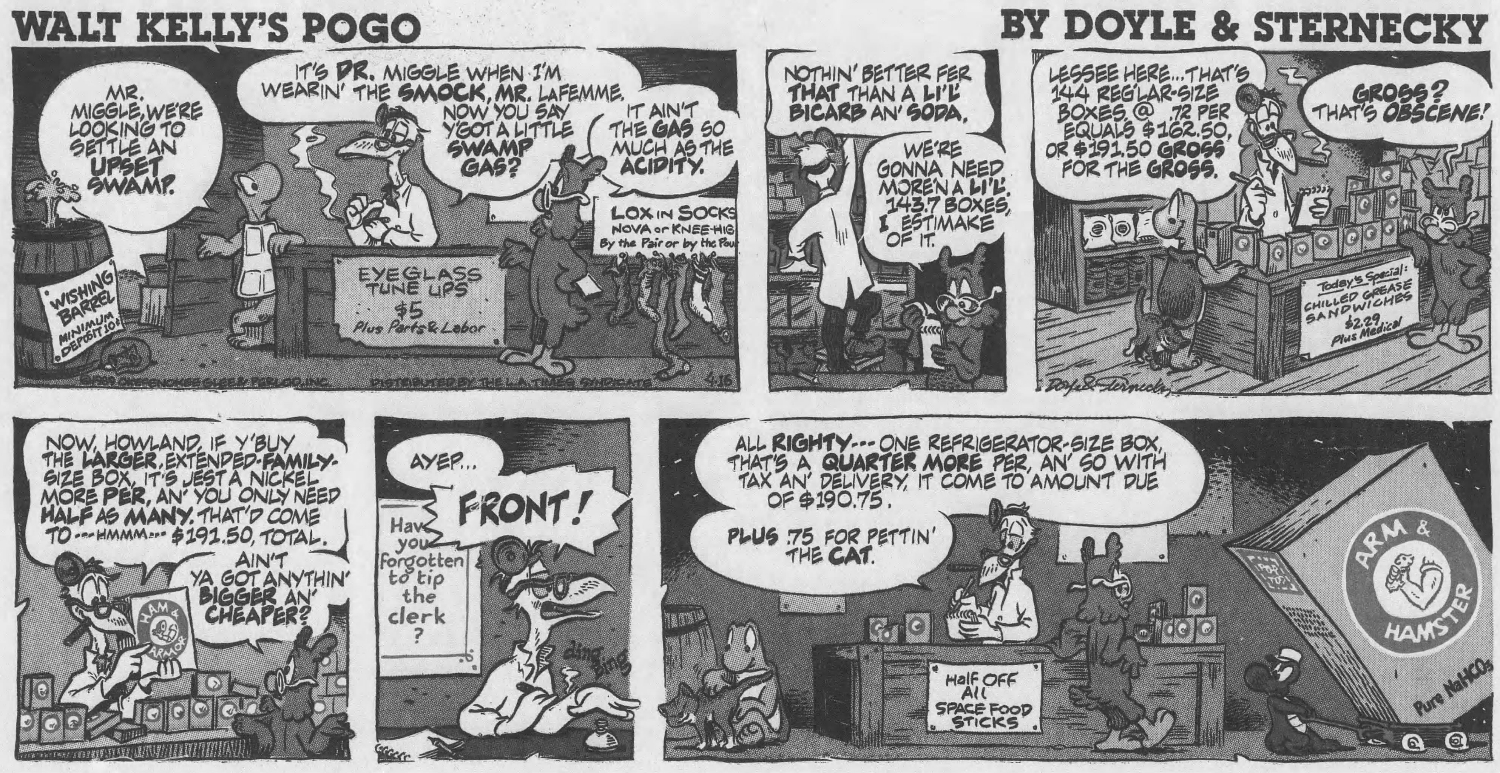
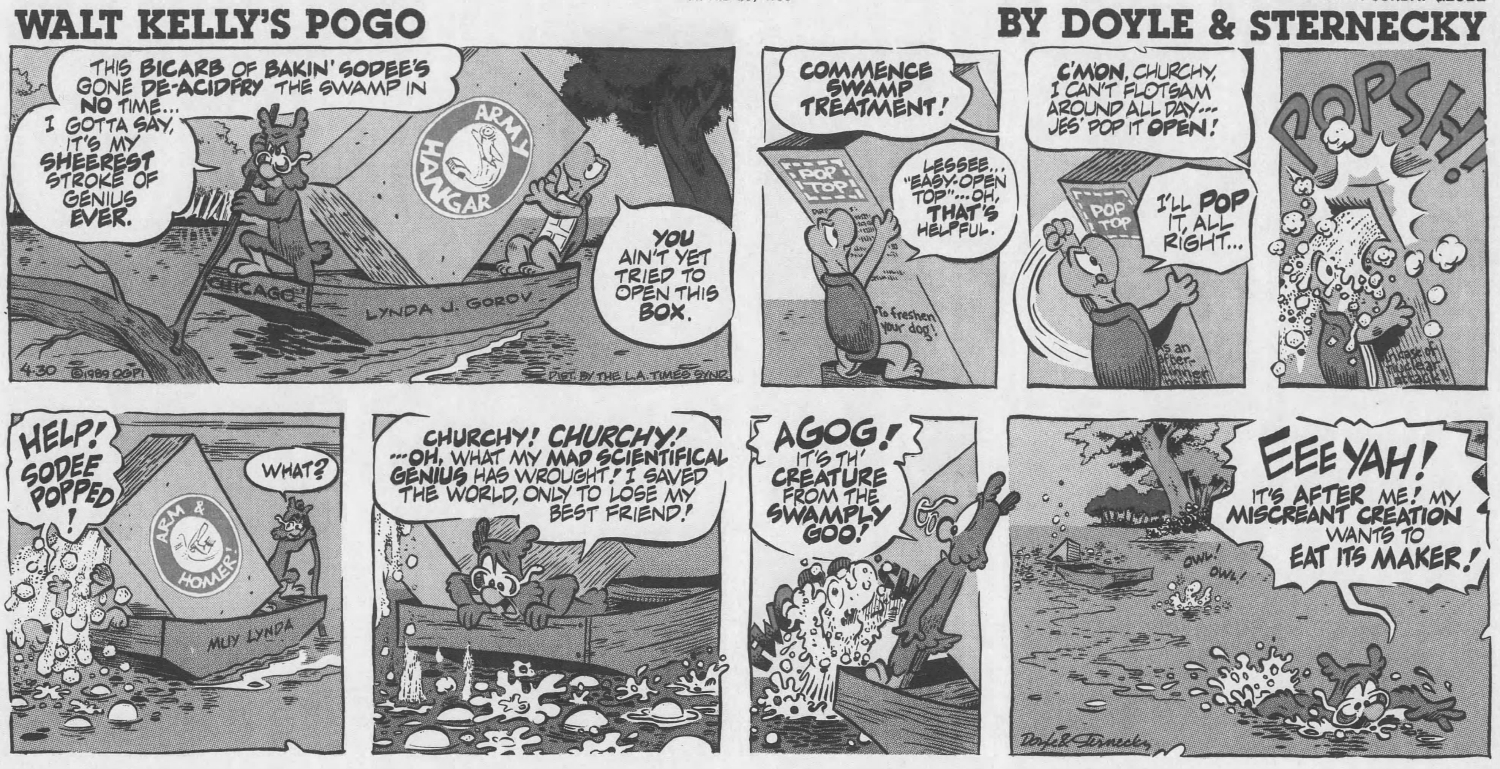
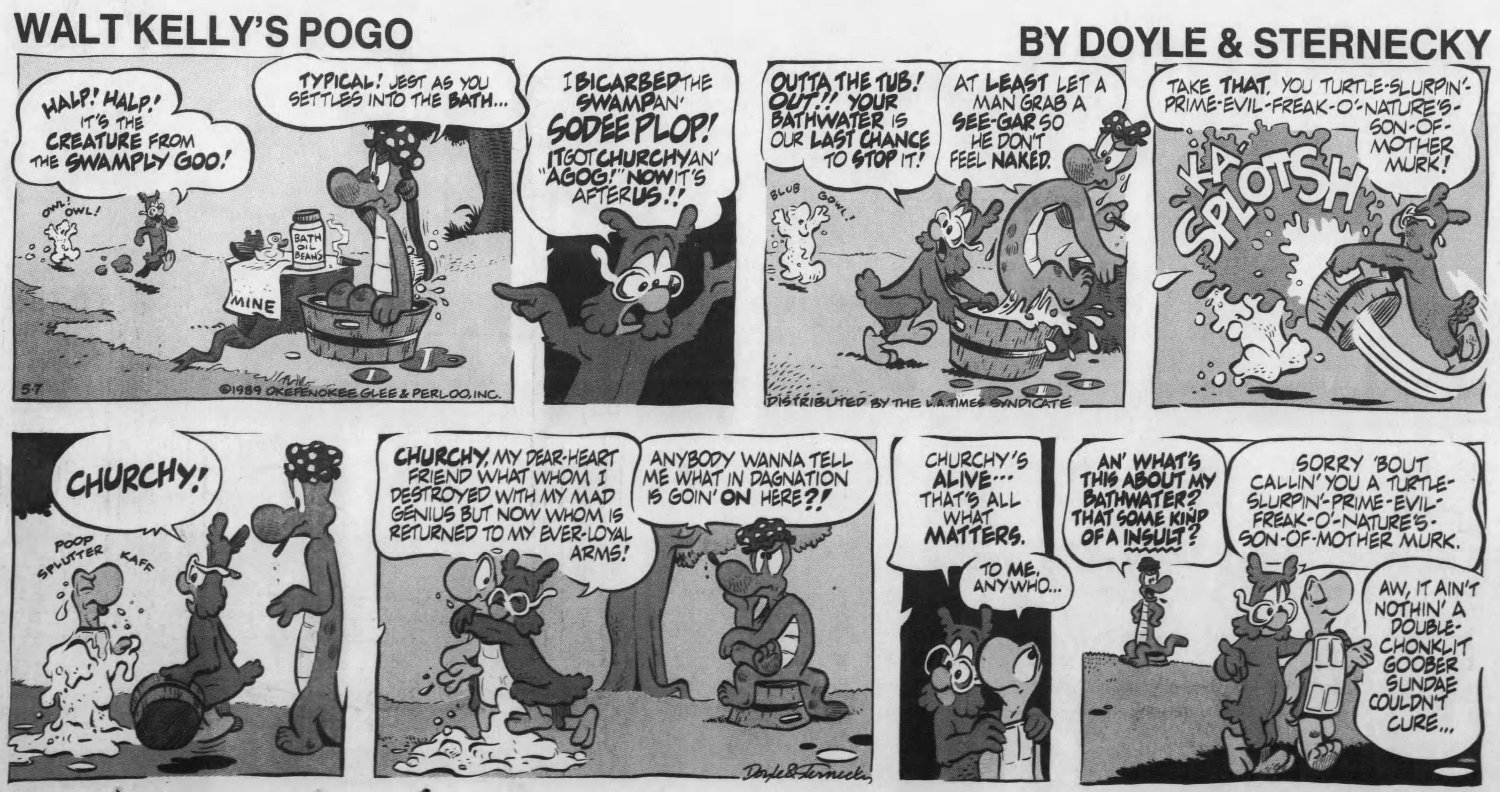
Somehow I recalled every bit of this bizarre "banana" arc below, especially how it ended. You don't easily forget a panel like "BAMAMA!!" I have no idea what it was trying to comment on. The War on Drugs maybe?
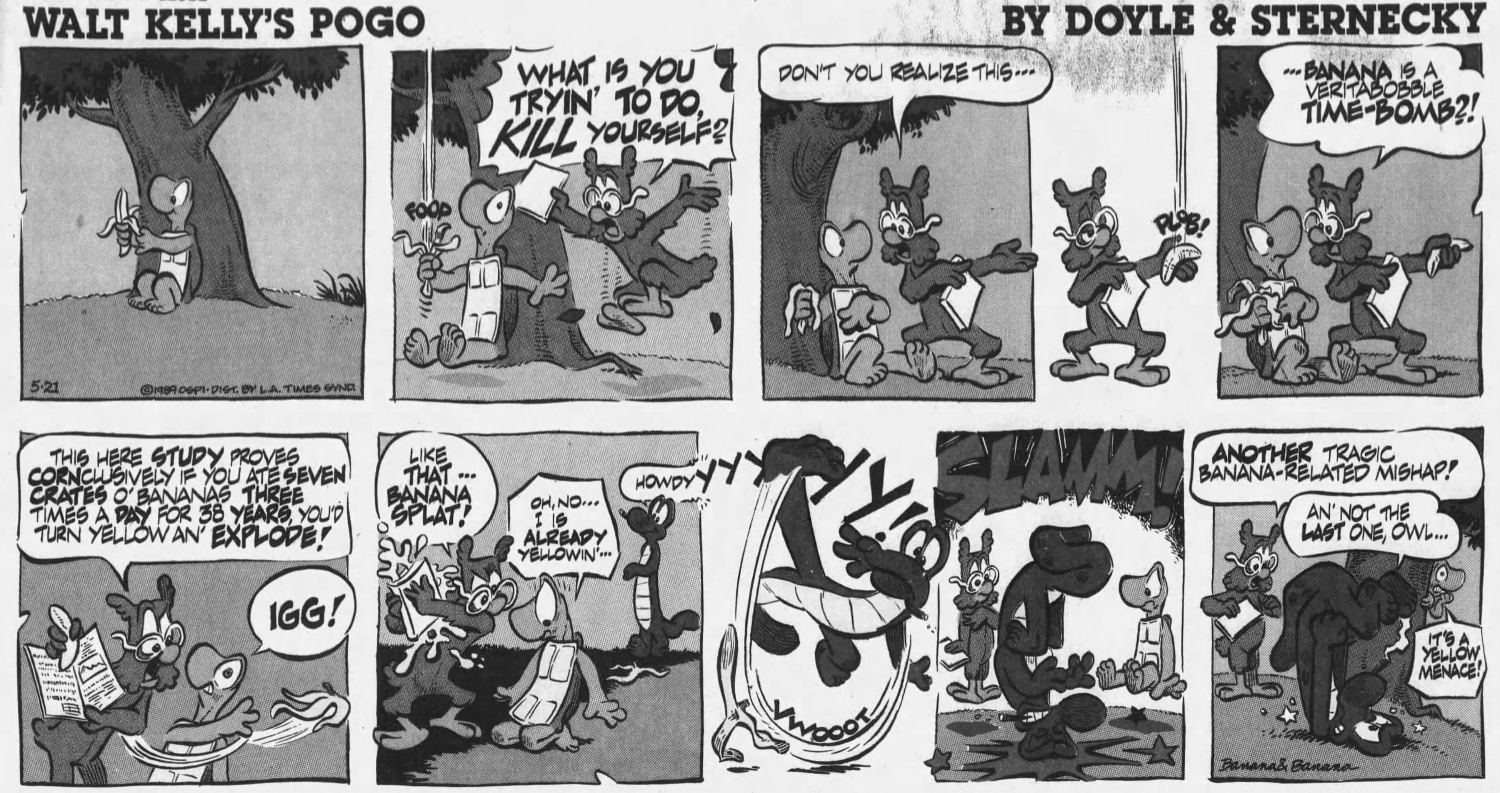
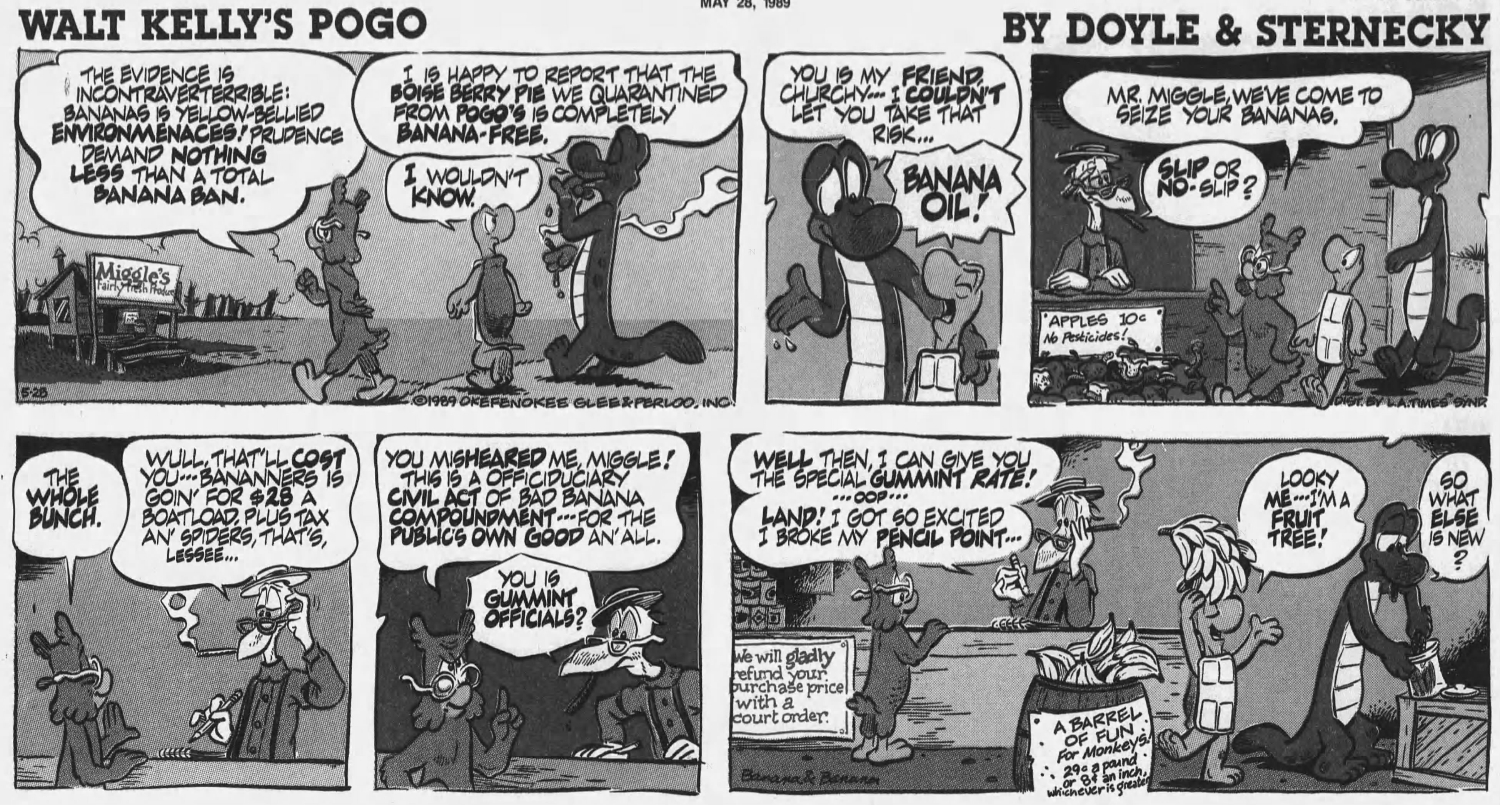
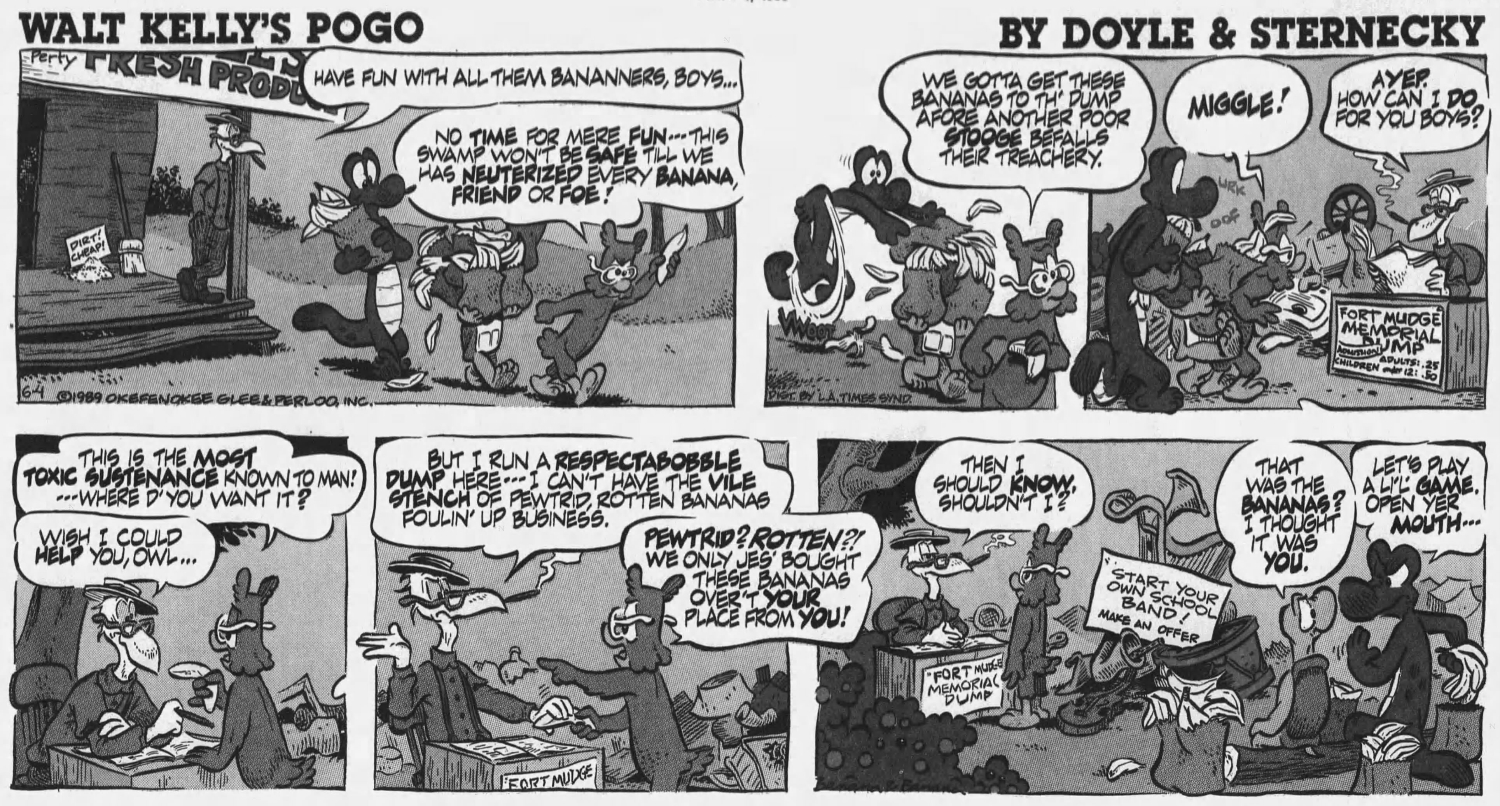
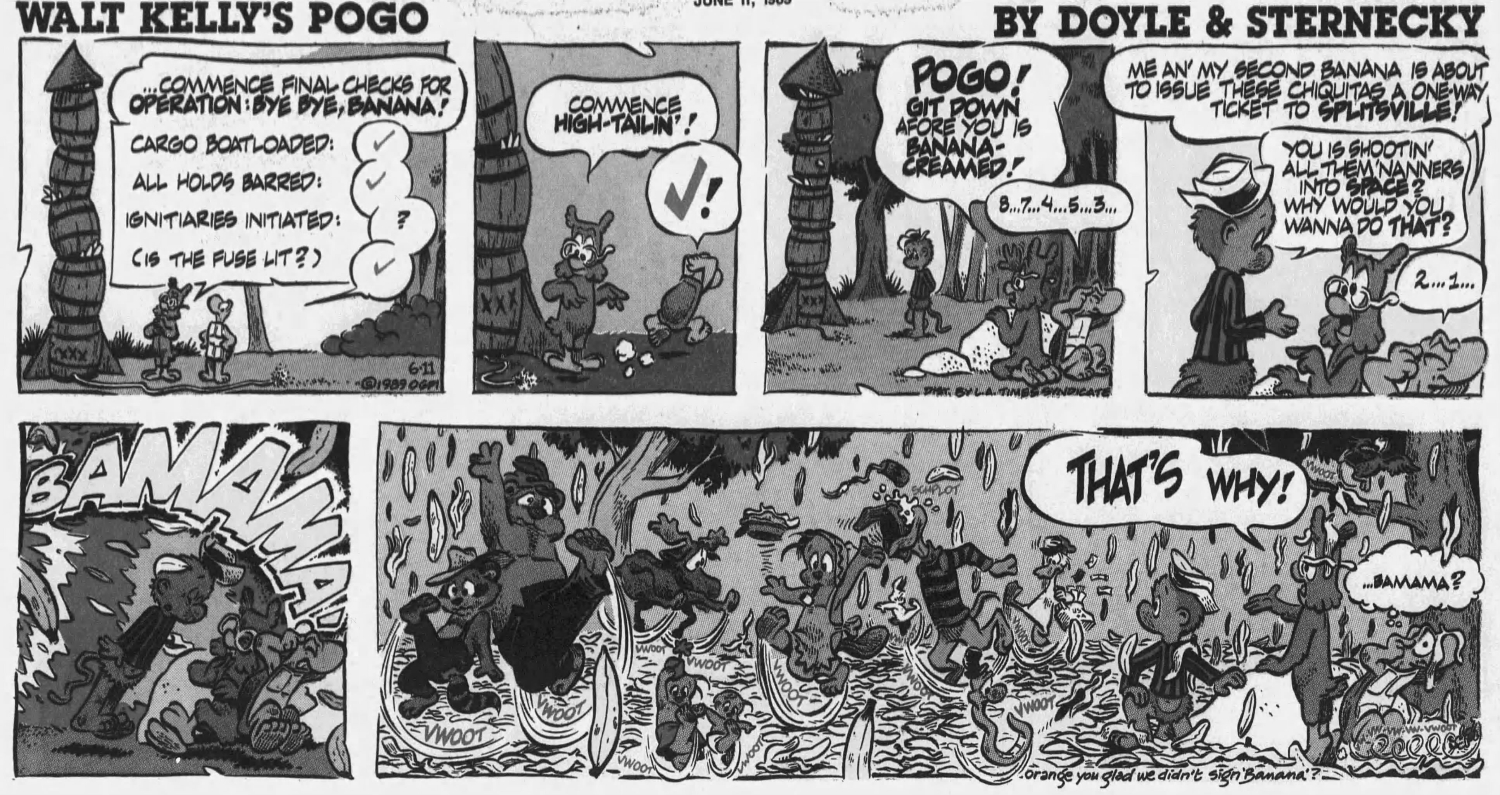
Following this is the arc I got cut off from, the one inspired by Michael Keaton's Batman movie breaking the box office. Though it's also a parody of Silver Age comic books in general.
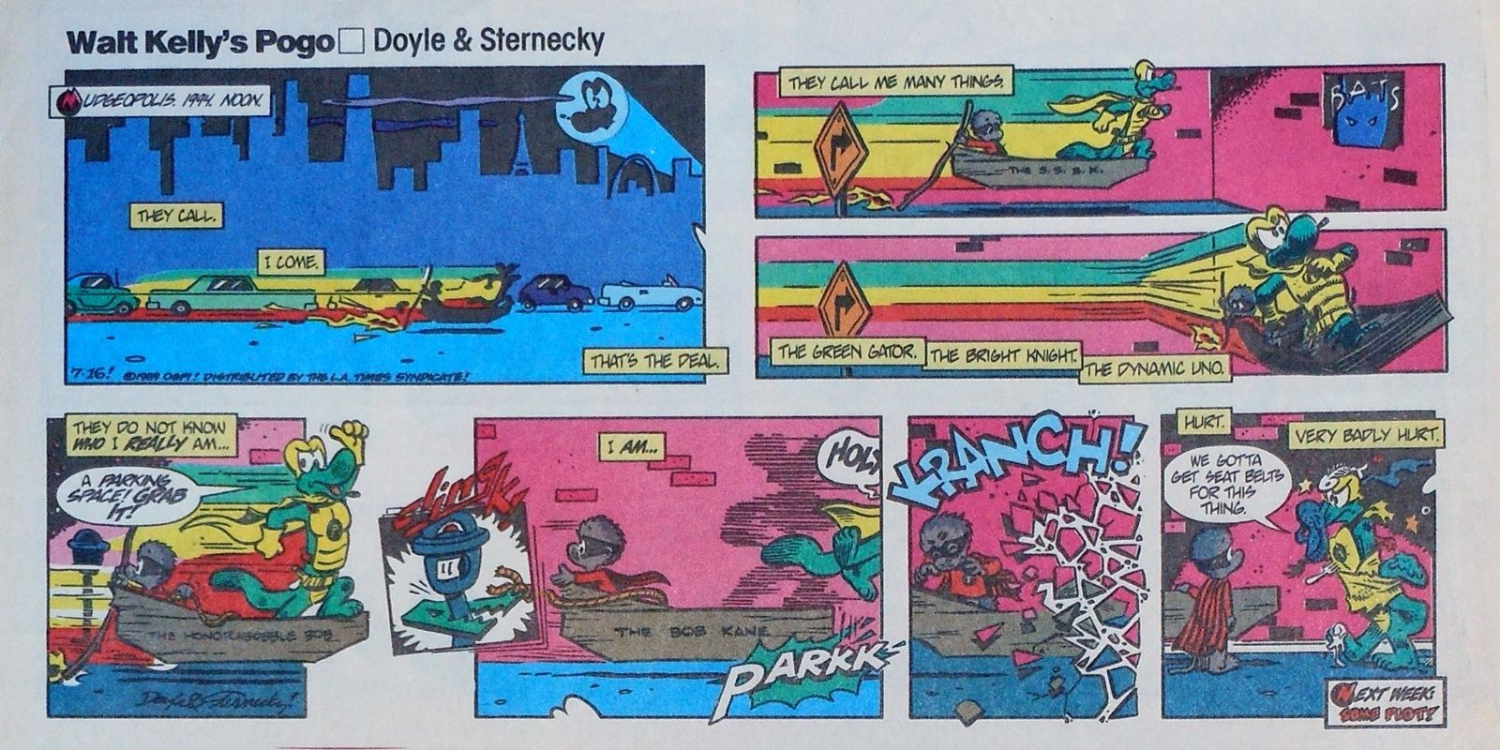
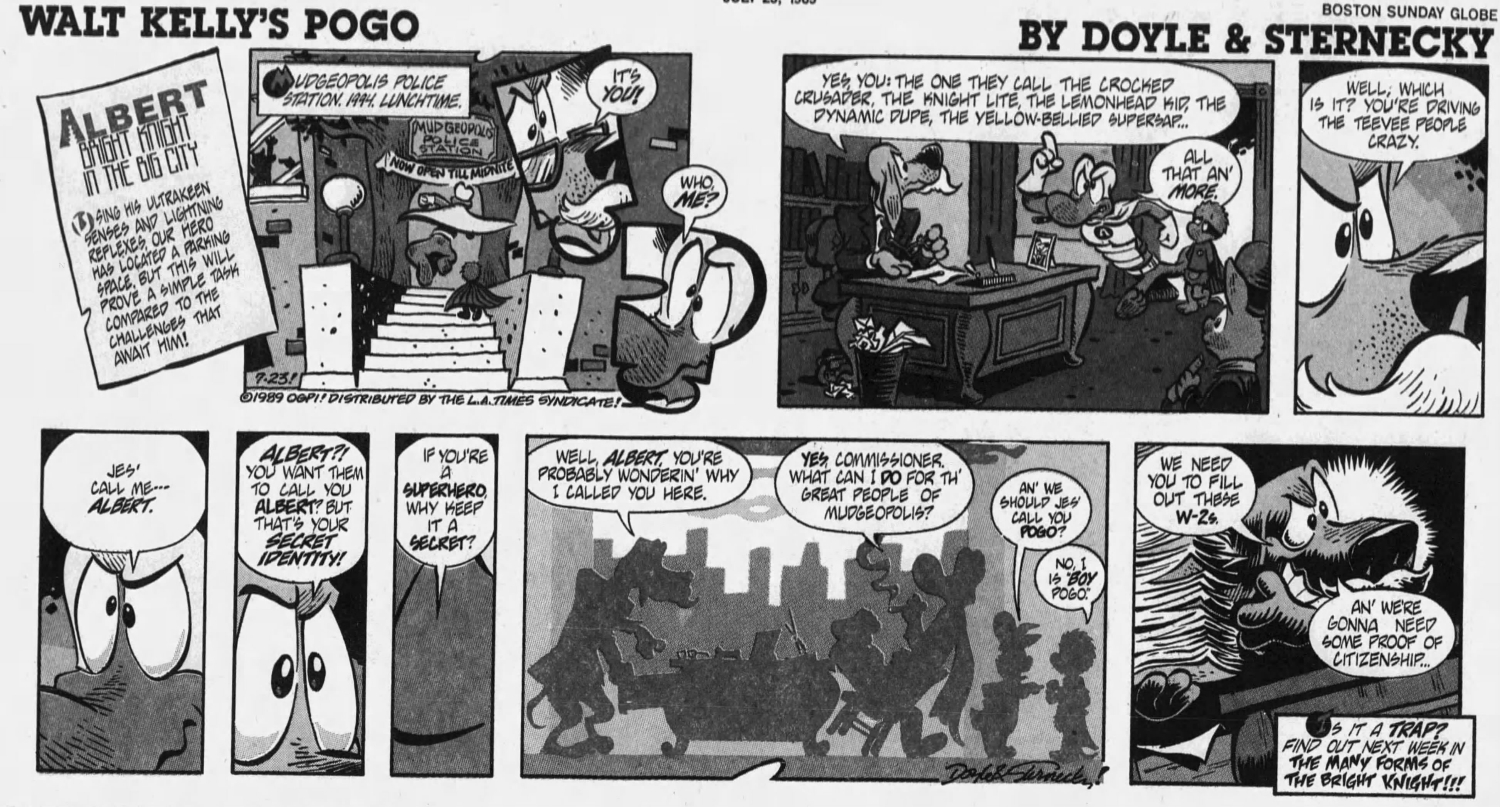
Y'know, I'm not entirely certain Kelly would've done this. But....I don't care. This sequence shows off some of the most inventive panel work I've ever seen within the restrictive format so many strips used. And I love the little details like Kelly's notches still being in the panel borders despite being straightened out.
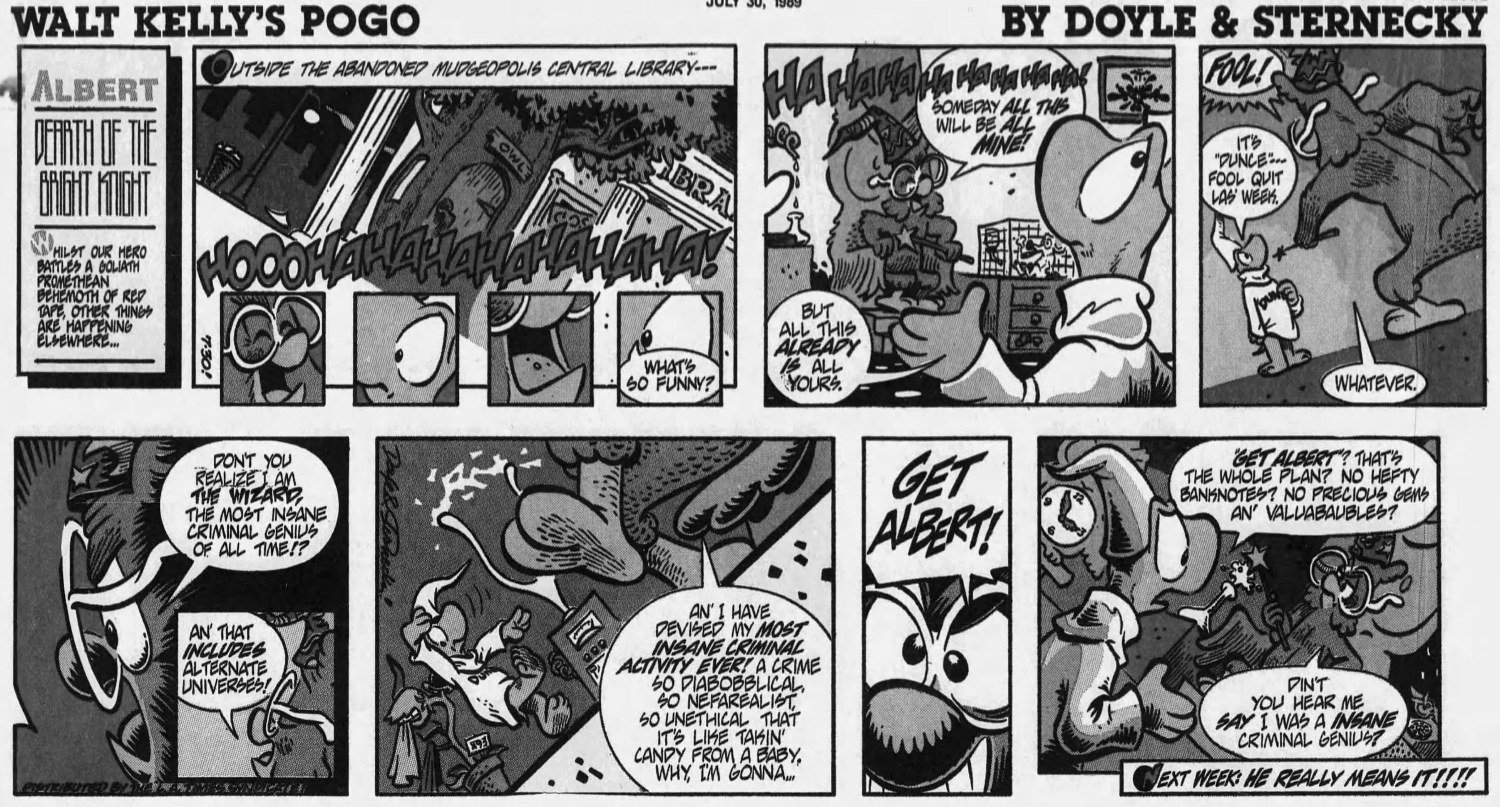
This is the last one my paper ran, so I didn't get to find out until now how The Wizard was going to "get Albert." Talk about a cliffhanger, right? I love all the visual gags like Churchy losing his balance on the Dutch angle.
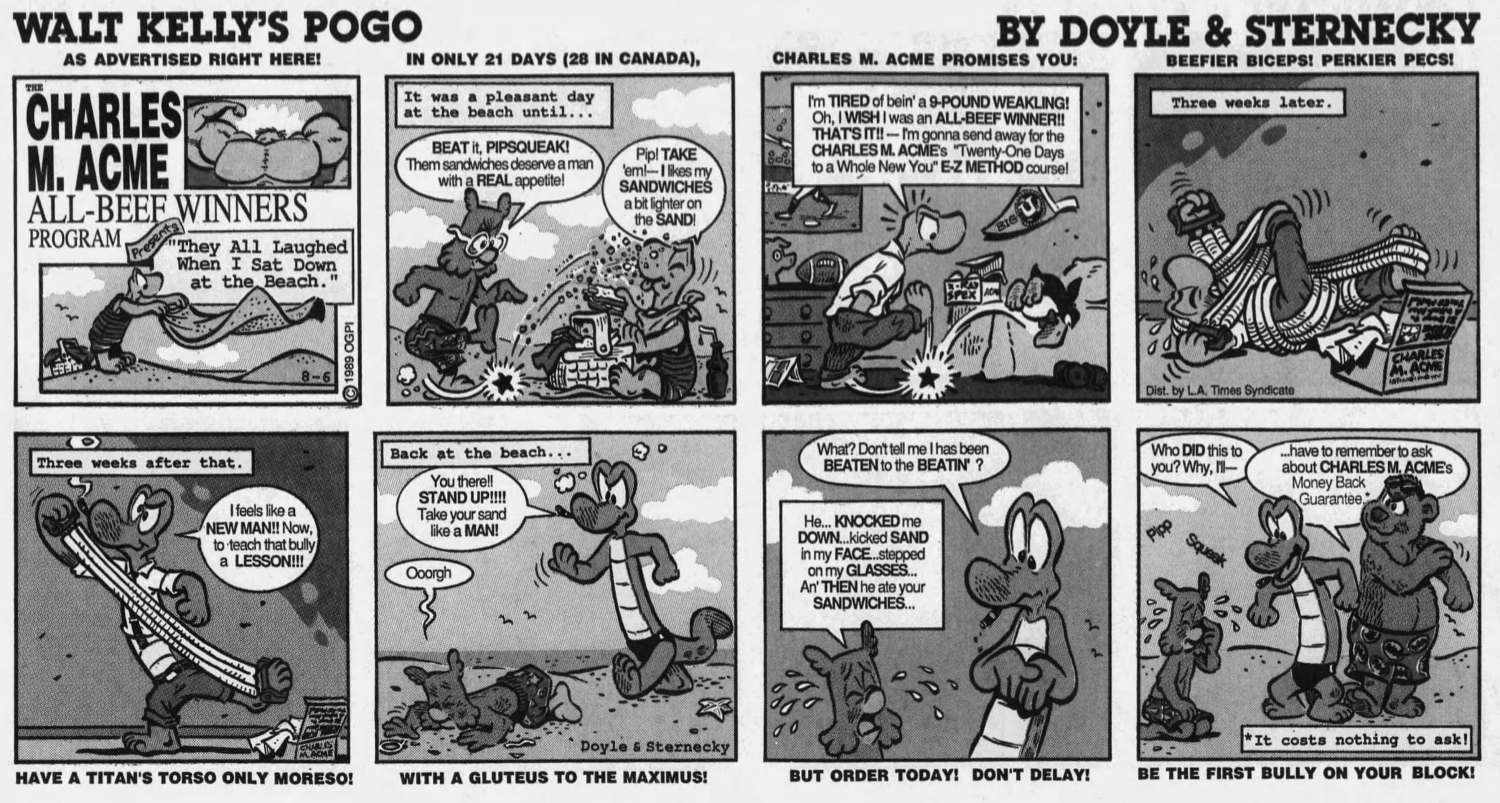
If we're spoofing comic books, then we have to make time for the "Charles Atlas Bodybuilding Course" parody. Thing is, with these chapters being separated by a week (and a totally different storyline on weekdays), doing this might have been confusing to some readers. It would've made more sense if they followed each other sequentially in the book collection that never happened.
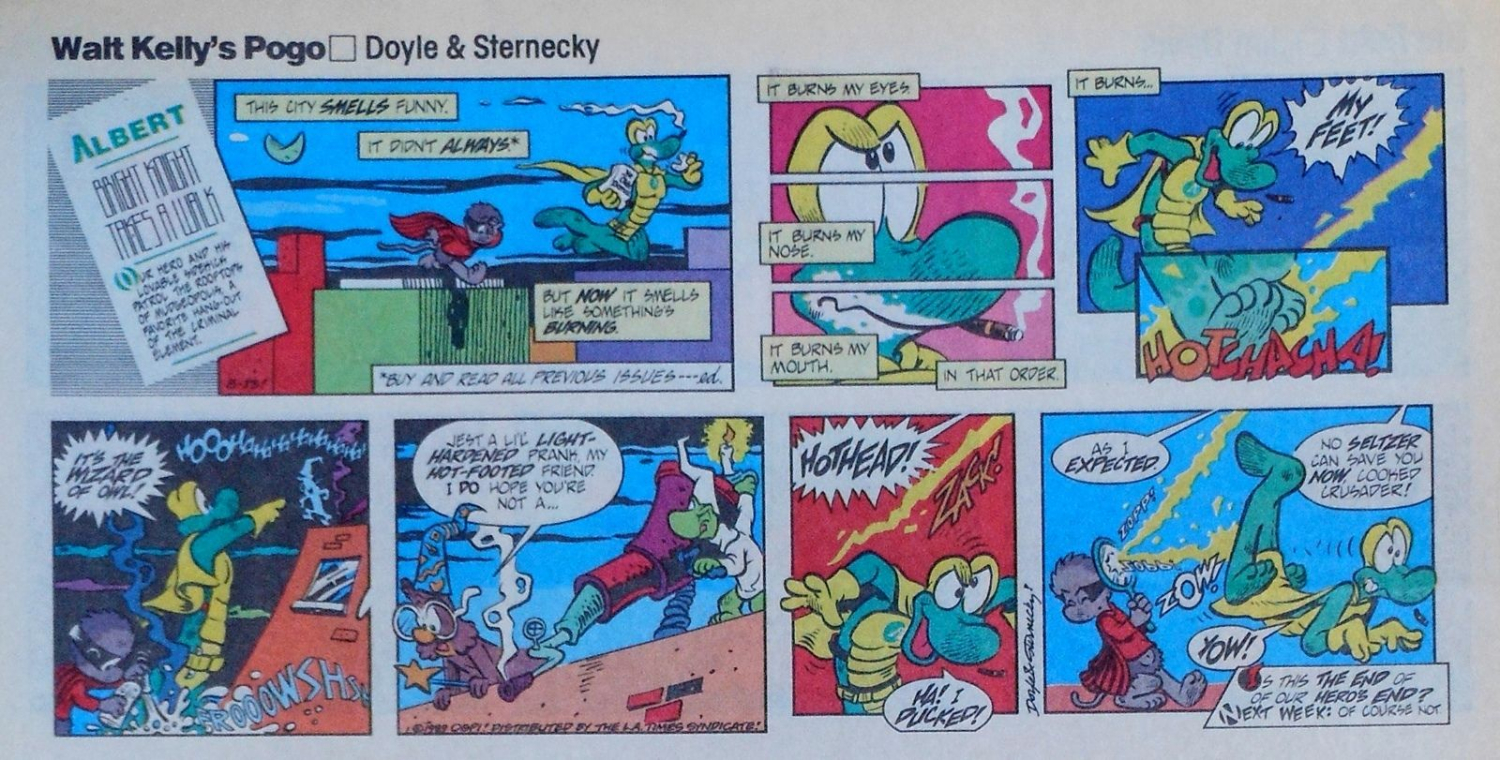
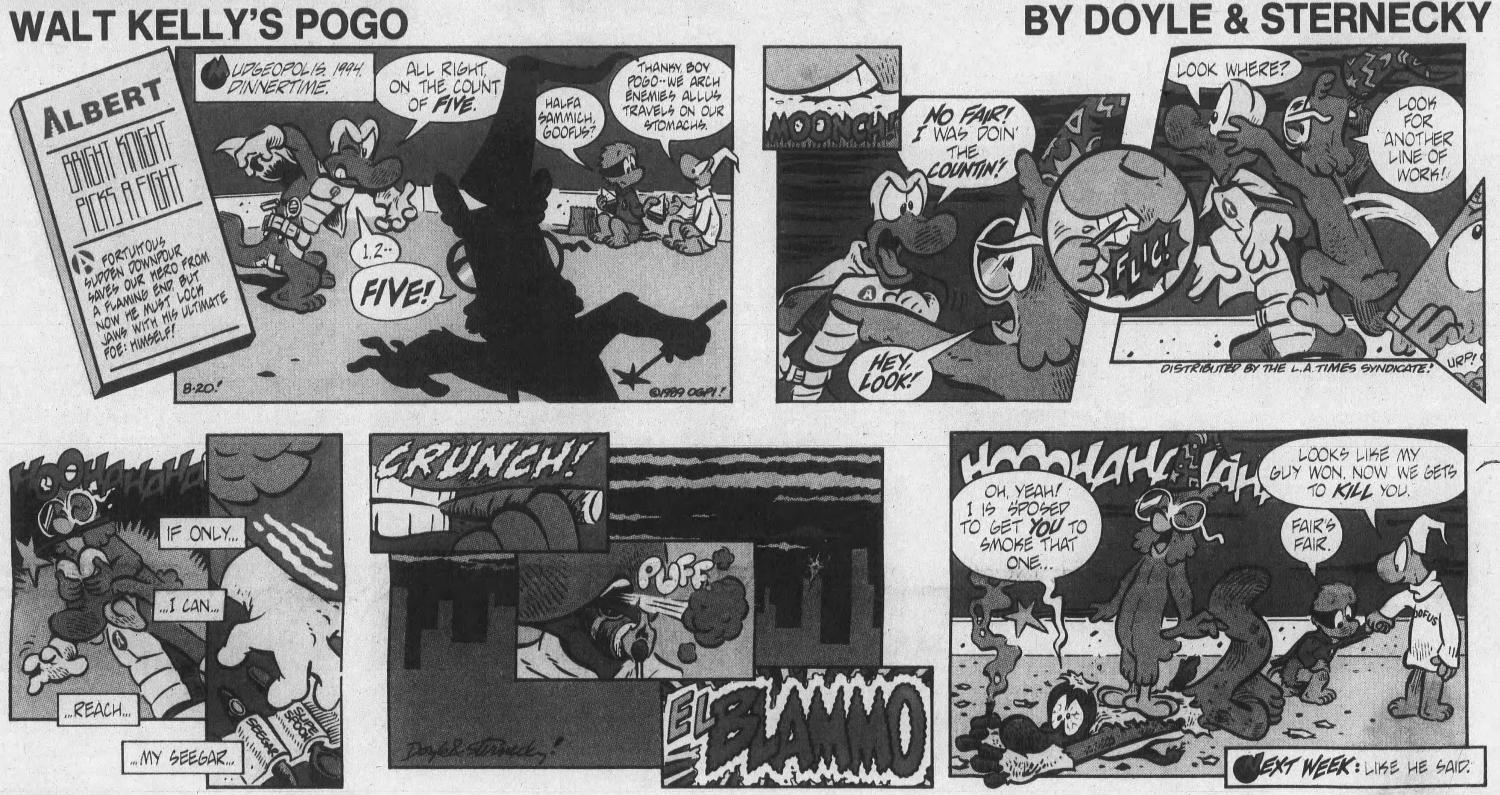
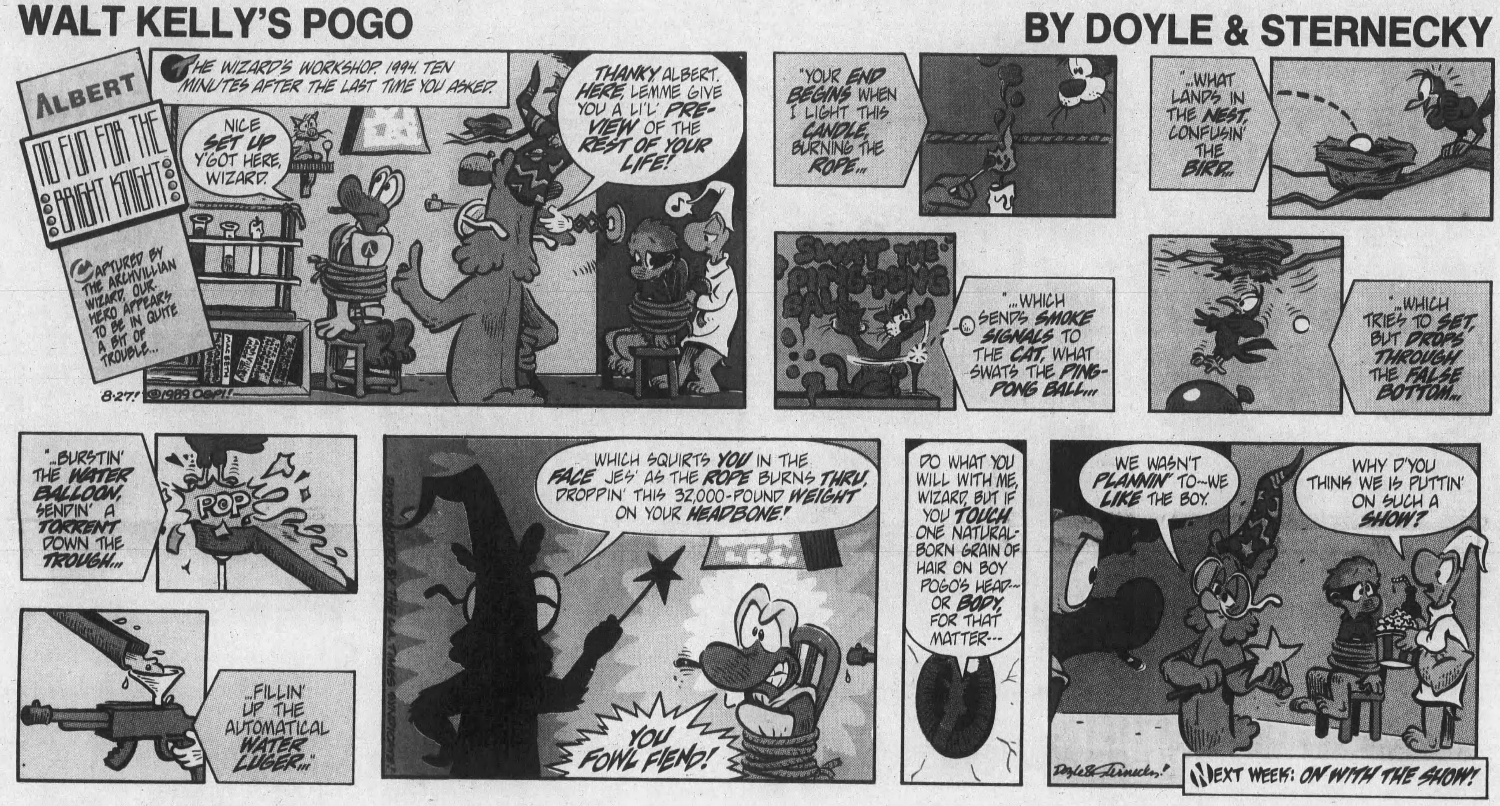
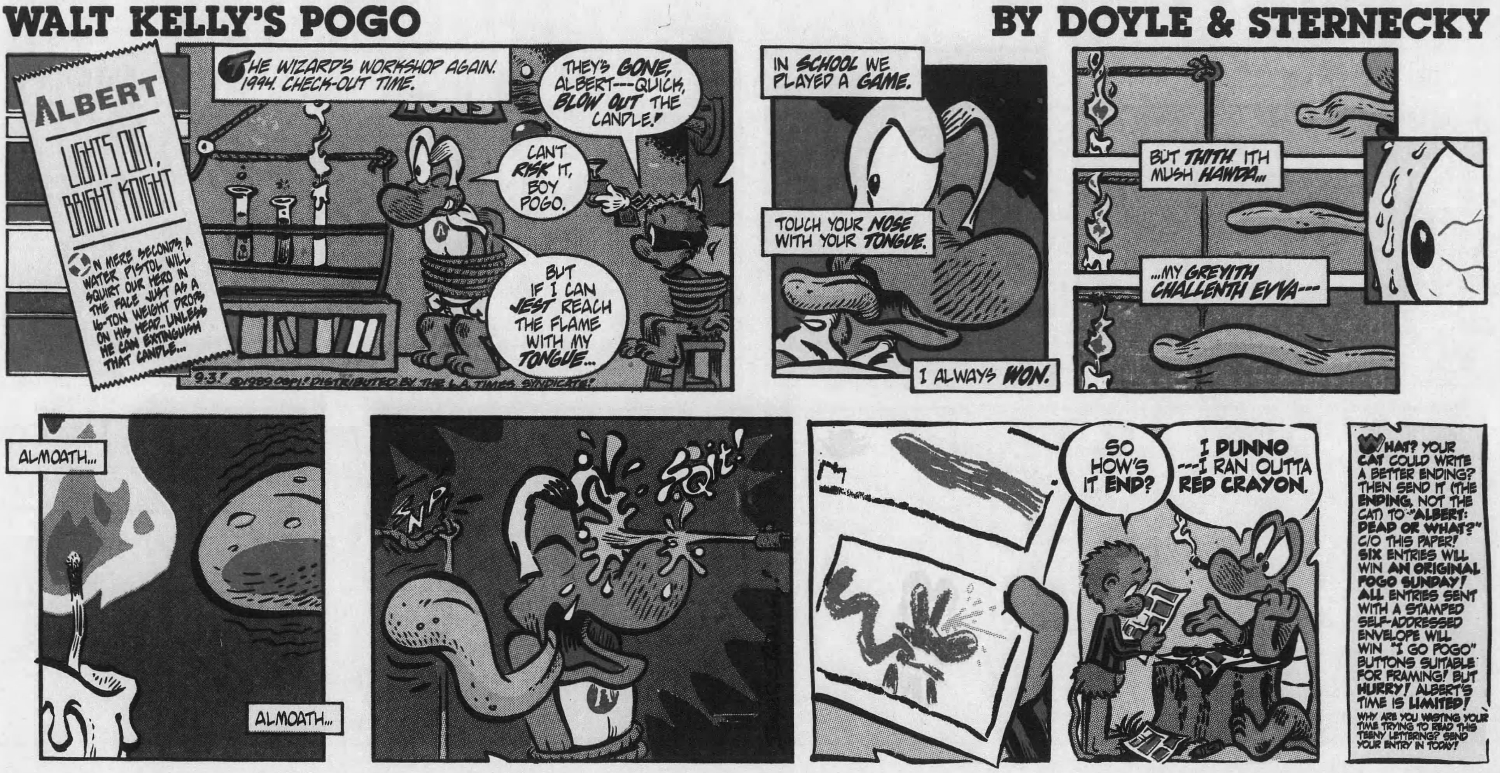
And there you have it -- the whole thing was a comic book Albert was drawing; that's our excuse. The final panel looks like a parody of DC's "tell us if Robin lives or dies" stunt they had pulled months before this ran. Was everyone going to get this? Probably not. But was it worth it? Totally. Wish I could've seen the whole stylish affair as a kid.
The Oregonian was one of the first to cancel Walt Kelly's Pogo, but far from the last. Subscriber numbers declined throughout 1990. In March of 1991, Larry Doyle quit the strip, leaving Sternecky to take over as writer AND artist. He continued solo for another year as papers continued to cancel, until splitting himself in March of 1992. And if you can believe it, two members of Kelly's family attempted to write and draw it themselves after that. This lackluster version of the strip paled in comparison to Walt, or even to Doyle and Sternecky. And by late 1993 nothing could be done to save it. After a spectacular introduction, that's how the ill-fated Pogo reboot ended....
